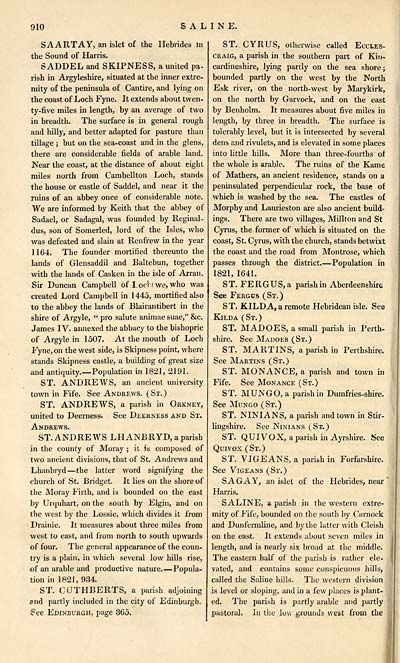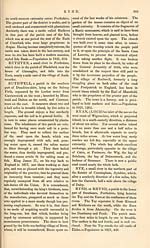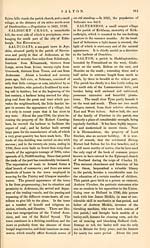Gazetteer of Scotland > Volume 2
(430) Page 910
Download files
Complete book:
Individual page:
Thumbnail gallery: Grid view | List view

910
SALINE.
SAARTAY, an islet of the Hebrides in
the Sound of Harris.
SADDEL and SKIPNESS, a united pa-
rish in Argyleshire, situated at the inner extre-
mity of the peninsula of Cantire, and lying on
the coast of Loch Fyne. It extends about twen-
ty-five miles in length, by an average of two
in breadth. The surface is in general rough
and hilly, and better adapted for pasture than
tillage ; but on the sea-coast and in the glens,
there are considerable fields of arable land.
Near the coast, at the distance of about eight
miles north from Cambellton Loch, stands
the house or castle of Saddel, and near it the
ruins of an abbey once of considerable note.
We are informed by Keith that the abbey of
Sadael, or Sadagal, was founded by Reginal-
ds, son of Somerled, lord of the Isles, who
was defeated and slain at Renfrew in the year
1164. The founder mortified thereunto the
lands of Glensaddil and Baltebun, together
with the lands of Casken in the isle of Arran.
Sir Duncan Campbell of Loci ; we, who was
created Lord Campbell in 1 445, mortified also
to the abbey the lands of Blairantibert in the
shire of Argyle, " pro salute animae suae," &c.
James IV. annexed the abbacy to the bishopric
of Argyle in 1507. At the mouth of Loch
Fyne, on the west side, is Skipness point, where
stands Skipness castle, a building of great size
and antiquity. — Population in 1821, 2191.
ST. ANDREWS, an ancient university
town in Fife. See Andrews. (St.)
ST. ANDREWS, a parish in Orkney,
united to Deerness. See Deerness and St.
Andrews.
ST. ANDREWS LHANBRYD, a parish
in the county of Moray ; it is composed of
two ancient divisions, that of St. Andrews and
Lhanbryd — the latter word signifying the
church of St. Bridget. It lies on the shore of
the Moray Firth, and is bounded on the east
by Uiquhart, on the south by Elgin, and on
the west by the Lossie, which divides it from
Drainie. It measures about three miles from
west to east, and from north to south upwards
of four. The general appearance of the coun-
try is a plain, in which several low hills rise,
of an arable and productive nature. — Popula-
tion in 1821, 934.
ST. CUTHBERTS, a parish adjoining
*nd partly included in the city of Edinburgh.
i?ee Edinburgh, page 865.
ST. CYRUS, otherwise called Eccles-
craig, a parish in the southern part of Kin-
cardineshire, lying partly on the sea shore;
bounded partly on the west by the North
Esk river, on the north-west by Marykirk,
on the north by Garvock, and on the east
by Benholm. It measures about five miles in
length, by three in breadth. The surface is
tolerably level, but it is intersected by several
dens and rivulets, and is elevated in some places
into little hills. More than three-fourths of
the whole is arable. The ruins of the Kame
of Mathers, an ancient residence, stands on a
peninsulated perpendicular rock, the base of
which is washed by the sea. The castles of
Morphy and Laurieston are also ancient build-
ings. There are two villages, Millton and St
Cyrus, the former of which is situated on the
coast, St. Cyrus, with the church, stands betwixt
the coast and the road from Montrose, which
passes through the district. — Population in
1821, 1641.
ST. FERGUS, a parish in Aberdeenshire
See Fergus (St.)
ST. KILDA, a remote Hebridean isle. See
Kilda (St.)
ST. MADGES, a small parish in Perth-
shire. See Madoes (St.)
ST. MARTINS, a parish in Perthshire.
See Martins (St.)
ST. MONANCE, a parish and town in
Fife. See Monance (St.)
ST. M UN GO, a parish in Dumfries-shire.
See Mungo (St.)
ST. NINIANS, a parish and town in Stir-
lingshire. See Ninians (St.)
ST. QUI VOX, a parish in Ayrshire. See
Qui vox (St.)
ST. VIGEANS, a parish in Forfarshire.
See Vigeans (St.)
SAGAY, an islet of the Hebrides, near ]
Harris.
SALINE, a parish in the western extre-
mity of Fife, bounded on the south by Carnock
and Dunfermline, and by the latter with Cleish
on the east. It extends about seven miles in
length, and is nearly six broad at the middle.
The eastern half of the parish is rather ele-
vated, and contains some conspicuous hills,
called the Saline hills. The western division
is level or sloping, and in a few places is plant-
ed. The parish is partly arable and partly
pastoral. In the low grounds west from the
SALINE.
SAARTAY, an islet of the Hebrides in
the Sound of Harris.
SADDEL and SKIPNESS, a united pa-
rish in Argyleshire, situated at the inner extre-
mity of the peninsula of Cantire, and lying on
the coast of Loch Fyne. It extends about twen-
ty-five miles in length, by an average of two
in breadth. The surface is in general rough
and hilly, and better adapted for pasture than
tillage ; but on the sea-coast and in the glens,
there are considerable fields of arable land.
Near the coast, at the distance of about eight
miles north from Cambellton Loch, stands
the house or castle of Saddel, and near it the
ruins of an abbey once of considerable note.
We are informed by Keith that the abbey of
Sadael, or Sadagal, was founded by Reginal-
ds, son of Somerled, lord of the Isles, who
was defeated and slain at Renfrew in the year
1164. The founder mortified thereunto the
lands of Glensaddil and Baltebun, together
with the lands of Casken in the isle of Arran.
Sir Duncan Campbell of Loci ; we, who was
created Lord Campbell in 1 445, mortified also
to the abbey the lands of Blairantibert in the
shire of Argyle, " pro salute animae suae," &c.
James IV. annexed the abbacy to the bishopric
of Argyle in 1507. At the mouth of Loch
Fyne, on the west side, is Skipness point, where
stands Skipness castle, a building of great size
and antiquity. — Population in 1821, 2191.
ST. ANDREWS, an ancient university
town in Fife. See Andrews. (St.)
ST. ANDREWS, a parish in Orkney,
united to Deerness. See Deerness and St.
Andrews.
ST. ANDREWS LHANBRYD, a parish
in the county of Moray ; it is composed of
two ancient divisions, that of St. Andrews and
Lhanbryd — the latter word signifying the
church of St. Bridget. It lies on the shore of
the Moray Firth, and is bounded on the east
by Uiquhart, on the south by Elgin, and on
the west by the Lossie, which divides it from
Drainie. It measures about three miles from
west to east, and from north to south upwards
of four. The general appearance of the coun-
try is a plain, in which several low hills rise,
of an arable and productive nature. — Popula-
tion in 1821, 934.
ST. CUTHBERTS, a parish adjoining
*nd partly included in the city of Edinburgh.
i?ee Edinburgh, page 865.
ST. CYRUS, otherwise called Eccles-
craig, a parish in the southern part of Kin-
cardineshire, lying partly on the sea shore;
bounded partly on the west by the North
Esk river, on the north-west by Marykirk,
on the north by Garvock, and on the east
by Benholm. It measures about five miles in
length, by three in breadth. The surface is
tolerably level, but it is intersected by several
dens and rivulets, and is elevated in some places
into little hills. More than three-fourths of
the whole is arable. The ruins of the Kame
of Mathers, an ancient residence, stands on a
peninsulated perpendicular rock, the base of
which is washed by the sea. The castles of
Morphy and Laurieston are also ancient build-
ings. There are two villages, Millton and St
Cyrus, the former of which is situated on the
coast, St. Cyrus, with the church, stands betwixt
the coast and the road from Montrose, which
passes through the district. — Population in
1821, 1641.
ST. FERGUS, a parish in Aberdeenshire
See Fergus (St.)
ST. KILDA, a remote Hebridean isle. See
Kilda (St.)
ST. MADGES, a small parish in Perth-
shire. See Madoes (St.)
ST. MARTINS, a parish in Perthshire.
See Martins (St.)
ST. MONANCE, a parish and town in
Fife. See Monance (St.)
ST. M UN GO, a parish in Dumfries-shire.
See Mungo (St.)
ST. NINIANS, a parish and town in Stir-
lingshire. See Ninians (St.)
ST. QUI VOX, a parish in Ayrshire. See
Qui vox (St.)
ST. VIGEANS, a parish in Forfarshire.
See Vigeans (St.)
SAGAY, an islet of the Hebrides, near ]
Harris.
SALINE, a parish in the western extre-
mity of Fife, bounded on the south by Carnock
and Dunfermline, and by the latter with Cleish
on the east. It extends about seven miles in
length, and is nearly six broad at the middle.
The eastern half of the parish is rather ele-
vated, and contains some conspicuous hills,
called the Saline hills. The western division
is level or sloping, and in a few places is plant-
ed. The parish is partly arable and partly
pastoral. In the low grounds west from the
Set display mode to: Large image | Transcription
Images and transcriptions on this page, including medium image downloads, may be used under the Creative Commons Attribution 4.0 International Licence unless otherwise stated. ![]()
| Gazetteers of Scotland, 1803-1901 > Gazetteer of Scotland > Volume 2 > (430) Page 910 |
|---|
| Permanent URL | https://digital.nls.uk/97435982 |
|---|
| Description | Volume II: Glenbanchor to Zetland. |
|---|---|
| Attribution and copyright: |
|
| Description | By Robert Chambers and William Chambers. Glasgow: Blackie & Son, 1838. 2 volumes. |
|---|---|
| Shelfmark | NF.1461.g.7 |
| Additional NLS resources: | |

